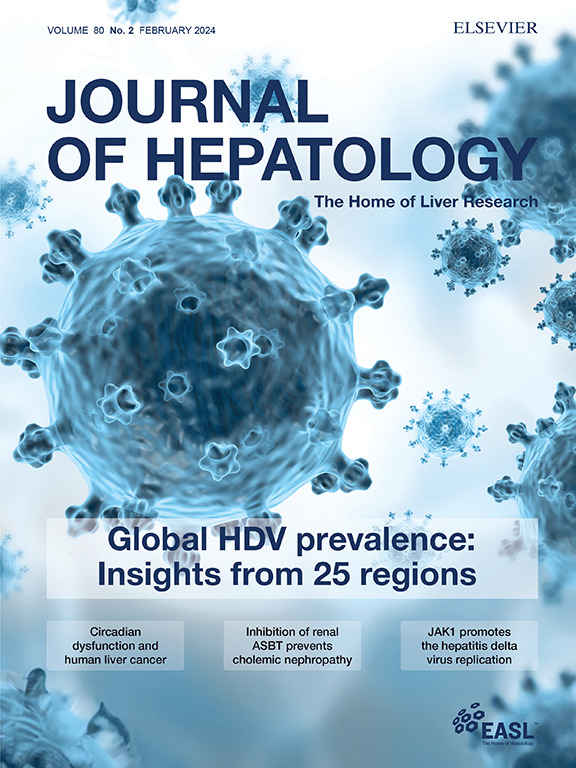磷脂酰乙醇水平可区分脂肪变性肝病亚组,并与主要肝脏结局的风险相关
IF 26.8
1区 医学
Q1 GASTROENTEROLOGY & HEPATOLOGY
引用次数: 0
摘要
背景,目的磷脂酰乙醇(PEth)是一种乙醇代谢物,用作近期饮酒的特定生物标志物。我们的目的是确定有PEth水平表明有害饮酒的代谢功能障碍相关脂肪变性肝病(MASLD)或有风险的患者的比例,并评估PEth水平与主要不良肝脏结局(MALOs)风险之间的关系。方法我们在2012年至2020年期间在瑞典斯德哥尔摩进行了一项队列研究(N=46,406),包括各种脂肪变性肝病(SLD)亚型患者和非SLD患者。在考虑竞争风险的情况下,计算不同组的malo累积发病率。Cox回归用于评估基线PEth水平与MALOs发生率之间的关系。结果6377例疑似MASLD患者中,1294例(20%)基线PEth水平在0.05 ~ 0.30 μmol/L (35 ~ 210 ng/ml)之间,提示过量饮酒(MetALD), 854例(13%)基线PEth值为0.30 μmol/L,提示酒精相关性肝病(ALD)。MASLD和PEth水平在0.05 ~ 0.30 μmol/L之间的患者与MASLD和PEth水平在0.05 μmol/L之间的患者FIB-4评分和肝硬化患病率中位数相似。与0.05 μmol/L的患者相比,0.05 ~ 0.30 μmol/L的患者MALOs的累积发病率更高。在没有肝硬化的患者中,即使在调整了年龄、性别、SLD亚型和FIB-4评分后,PEth水平升高与malo发生率升高显著相关。ALD患者的PEth水平最高,预后最差。结论speth是一种有价值的酒精生物标志物,可用于区分SLD亚型,尤其是ALD,并可预测SLD患者和非SLD患者的不良结局。影响和意义关于各种提出的脂肪变性肝病(SLD)亚型存在争议,最近的定义表明,酒精摄入量升高和MASLD的患者应归类为MetALD。在这里,我们通过利用生物标志物磷脂酰乙醇(PEth)对SLD患者进行分类来解决这一挑战,PEth是近期饮酒的直接可靠的生物标志物。我们对46,406名患者的分析表明,使用客观的PEth生物标志物可能是区分MASLD和MetALD的有价值的工具,并且PEth与患有和不患有已知SLD的个体的肝脏结局风险密切相关。将PEth检测纳入常规诊断评估可以提高对SLD潜在病理生理学的认识,减少错误分类的可能性,并最终通过使临床医生提供适当的治疗来改善患者的预后。需要进一步的研究来在其他人群中验证这些发现,并探索将PEth纳入管理SLD的更广泛临床指南的可能性。本文章由计算机程序翻译,如有差异,请以英文原文为准。

Phosphatidylethanol levels distinguish steatotic liver disease subgroups and are associated with risk of major liver outcomes
Background & Aims
Phosphatidylethanol (PEth) is an ethanol metabolite used as a specific biomarker for recent alcohol consumption. We aimed to determine the proportion of patients with or at risk for metabolic dysfunction-associated steatotic liver disease (MASLD) who had PEth levels indicative of harmful alcohol consumption, and to assess associations between PEth levels and the risk of major adverse liver outcomes (MALOs).Methods
We conducted a cohort study involving persons tested for PEth in Stockholm, Sweden between 2012 and 2020 (N=46,406), including patients with various steatotic liver disease (SLD) subtypes and individuals without SLD. Cumulative incidences of MALOs were calculated for the different groups while accounting for competing risk. Cox regression was used to evaluate the association between baseline PEth levels and the incidence of MALOs.Results
Among 6,377 patients with presumed MASLD, 1,294 (20%) had baseline PEth levels between 0.05 and 0.30 μmol/L (35-210 ng/ml), indicating excessive alcohol intake (MetALD), while 854 patients (13%) had values >0.30 μmol/L, indicating alcohol-related liver disease (ALD). Patients with MASLD and PEth levels between 0.05-0.30 μmol/L had similar median FIB-4 scores and cirrhosis prevalence as those with MASLD and PEth levels <0.05 μmol/L. However, patients with PEth levels between 0.05-0.30 μmol/L had higher cumulative incidences of MALOs compared to those with PEth levels <0.05 μmol/L. Elevated PEth levels were significantly linked to higher rates of MALOs in patients without cirrhosis, even after adjustments for age, sex, SLD subtype, and FIB-4 score. Patients with ALD had the highest PEth levels and worst prognosis.Conclusions
PEth is a valuable alcohol biomarker for distinguishing between SLD subtypes, especially ALD, and predicts adverse outcomes in people with and without SLD.Impact and implications
There is controversy regarding the various proposed steatotic liver disease (SLD) subtypes, the most recent definition suggesting that patients with an elevated alcohol consumption and MASLD should be classified as having MetALD. Here, we address this challenge by classifying patients with SLD by utilizing the biomarker phosphatidylethanol (PEth), a direct and reliable biomarker for recent alcohol consumption. Our analysis of this large cohort—comprising 46,406 patients—revealed that using the objective PEth biomarker may be a valuable tool for distinguishing between MASLD and MetALD, and that PEth is strongly associated with the risk of liver outcomes in individuals with and without known SLD.Integrating PEth testing into routine diagnostic evaluations could enhance knowledge on the underlying pathophysiology in SLD, reduce the potential for misclassification, and ultimately improve patient outcomes by enabling clinicians to offer appropriate therapies. Further research is needed to validate these findings in other populations and to explore the potential integration of PEth into broader clinical guidelines for managing SLD.求助全文
通过发布文献求助,成功后即可免费获取论文全文。
去求助
来源期刊

Journal of Hepatology
医学-胃肠肝病学
CiteScore
46.10
自引率
4.30%
发文量
2325
审稿时长
30 days
期刊介绍:
The Journal of Hepatology is the official publication of the European Association for the Study of the Liver (EASL). It is dedicated to presenting clinical and basic research in the field of hepatology through original papers, reviews, case reports, and letters to the Editor. The Journal is published in English and may consider supplements that pass an editorial review.
 求助内容:
求助内容: 应助结果提醒方式:
应助结果提醒方式:


